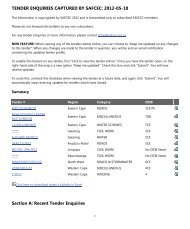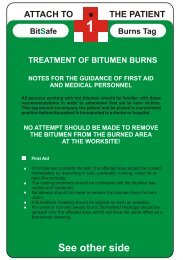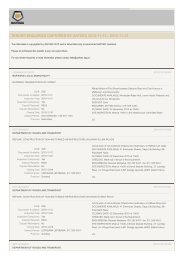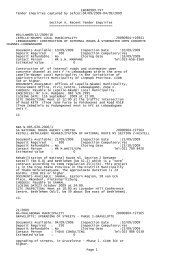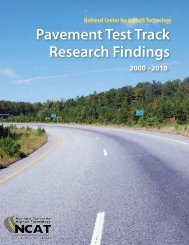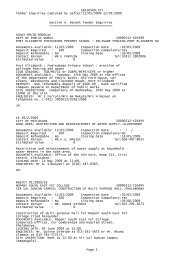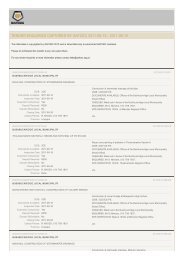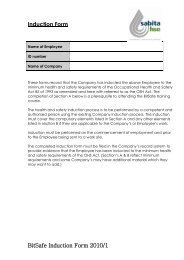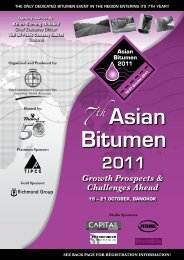DIGEST 2006 - Sabita
DIGEST 2006 - Sabita
DIGEST 2006 - Sabita
You also want an ePaper? Increase the reach of your titles
YUMPU automatically turns print PDFs into web optimized ePapers that Google loves.
promote the breaking of the<br />
emulsion. It also enhances early<br />
mosaic development of the stone<br />
matrix in a seal.<br />
The quantity of flux in cationic<br />
spray grade is varied on a<br />
seasonal basis, with the higher<br />
hydrocarbon levels being used<br />
during winter months. SABS 548<br />
specifies a maximum allowable<br />
flux level of 5% m/m of residual<br />
binder. Should cationic spray<br />
grade emulsion be used as a tack<br />
coat, the flux component will be<br />
trapped under the overlaid<br />
material. Although generally not a<br />
problem in most paving<br />
applications, the use of cationic<br />
spray grade emulsions should be<br />
avoided on high stress areas, due<br />
to possible problems with slippage<br />
or creeping of the asphalt layer.<br />
Anionic stable grade emulsions<br />
contain no hydrocarbon solvents<br />
and are thus preferable for tack<br />
coat applications.<br />
Typical properties<br />
No national specifications exist for<br />
bond coat emulsions. These<br />
emulsions are supplied by the<br />
manufacturers, who provide their<br />
own specifications. Typical<br />
properties used to classify a bond<br />
coat emulsion are: binder content,<br />
viscosity and residue on sieve<br />
values. Minimum softening point<br />
and elastic recovery values are<br />
specified on the residual binder<br />
after evaporation of the water<br />
phase. These properties should<br />
comply with the requirements of<br />
TG1’s SC-E1 grade modified<br />
emulsion for seals, except that the<br />
product must not contain any<br />
hydrocarbon fluxes. It is possible<br />
that the specifications for these<br />
emulsions will be included in the<br />
revised TG1 guideline to be<br />
published later this year.<br />
European developments<br />
A common problem associated<br />
with the use of tack coats is “pick<br />
up” of the broken emulsion<br />
residue under the wheels of the<br />
tipper trucks supplying the hot mix<br />
asphalt to the pavers. This<br />
effectively results in areas where<br />
little or no binder remains on the<br />
surface, which can result in<br />
slippage cracking or delamination<br />
of the asphalt layer.<br />
A new type of tack coat emulsion,<br />
such as the Colnet system<br />
registered in the name of Colas SA<br />
in France, has been developed in<br />
Europe, and is known as “clean<br />
emulsion”. Essentially a hard<br />
grade of bitumen is emulsified<br />
using specialised equipment, and<br />
the emulsion is applied with a<br />
specially adapted binder<br />
distributor using three spray bars.<br />
The first spray bar applies an<br />
adhesion agent to the existing<br />
surface, while the second, or main<br />
bar, applies the emulsion. The<br />
third spray bar applies a chemical<br />
“breaking agent” on the emulsion<br />
to destabilise the emulsion and<br />
induce chemical breaking. Paving<br />
can commence immediately after<br />
application of the emulsion and<br />
“pick-up” on the truck tyres does<br />
not occur (see Figure 2). This<br />
system allows paving work to<br />
proceed at night, with no delays<br />
being caused by slow breaking of<br />
the tack coat.<br />
135



